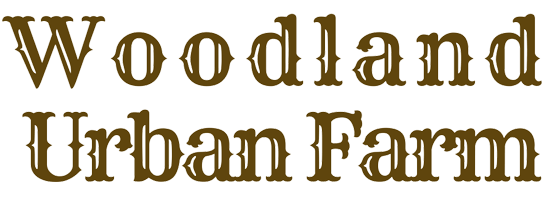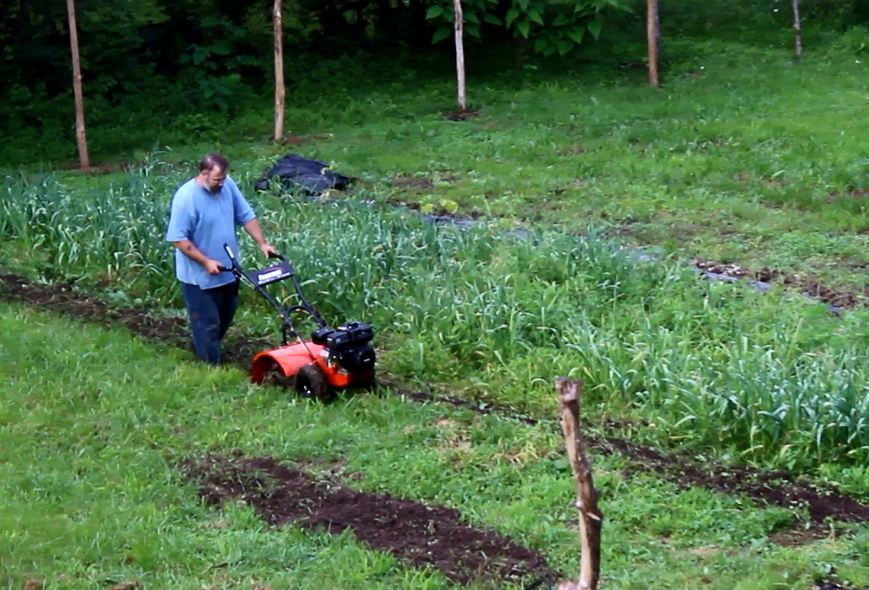
I spent this evening in the woods with a stencil and a backpack full of spray paint cans. I was marking selected trees: M for maple, W for black walnut, and X for dead trees to be cut down. I’m going to try my hand at making syrup next spring (late winter, really). It’s hard to get through those woods without getting scratched up, though. It’s so overgrown with multiflora roses, blackberries–vines and honeysuckle, too, but at least those don’t have thorns. I cut vines when I see them choking the trees, but there’s really no good way to clear out the rest of that stuff other than goats, which we don’t have.
I’ve been researching goats, seeing how feasible it would be to raise them here. On the plus side, we wouldn’t have to feed them much (if anything) as long as we didn’t have too many. Also on the plus side, we’re located just a couple blocks south of a large Somali community, with halal markets nearby. According to a report by OSU, Columbus Somalis eat 14,000 goats a year, most of which come from Detroit. There are several butcher shops in Ohio where I could take them, either to sell or to have butchered so I could sell the meat myself. I wouldn’t have to worry about goats being eaten by raccoons, foxes, opossums, or minks. Having goat milk would allow us to make fudge and soap, or to feed some pigs. And of course, they’d manage the weeds.
On the down side, we’d have to fence the whole property before we could even start. Goats are more expensive than chickens, and it takes longer for them to reach slaughter weight. They require more veterinary care than chickens do. I’d have no intention of investing in the necessary facilities to be able to produce milk or cheese for sale–and I’d rather not deal with the daily hassle of milking (though Mayda says she wouldn’t mind). The closest goat butcher I know of is Blystone/Harrison Farm in Canal Winchester, and I don’t know that they’d cut mine up for me, especially since I’d be cutting into their meat sales. Regardless of where I’d want to take them, I don’t currently have a truck or even a car that works. And even then, I don’t know that the local goat consumers are willing to pay any kind of premium for locally grown if they can get it cheaper from Michigan…or Texas, or Australia.
Obviously, then, there’s a lot to consider before deciding whether to start raising goats.
One of the things that troubles me about the business plan I started with is that it’s so heavily reliant on outside inputs. I buy chicks, I buy feed, I buy bedding, then I put them all together and try to make a profit selling the final product. You might as well call it manufacturing. I still want to raise chickens, but I’d like to move toward more of the farm’s income being generated by the land itself. I don’t have the acreage or machinery to grow all the grain I’d need to feed chickens. Woodland makes poor pasture for sheep or cattle, and I have no intention of clear cutting our forest to make grazing land. Pigs like the woods, but I’d still have to bring in feed from outside. LOTS of it.
This is why I was thinking of goats. They’re well suited to our ecology. They eat what grows here; I wouldn’t even have to plant their feed. Fans of Joel Salatin will remember that his whole business model is based on grass farming, selling the critters that eat the grass, with both the grass and the critters replenishing themselves each year. I need something like that…something other than pawpaws. We had a good pawpaw harvest this year, but very poor sales. (On the bright side, I have a lot of really ripe pawpaws in my fridge I’m going to make something out of tomorrow. I’m thinking a pawpaw cream pie.) A few people said they were interested, but then never showed up to buy any. I had one sale: someone who had me ship them out to Arizona so her aunt could take a trip down memory lane. That was rewarding, being able to share in making someone happy like that, but one sale doesn’t pay the bills, y’know? There’s no “going out of business,” because as long as we live here and the trees keep fruiting, I’ll have something to sell…but languishing on the edge of bankruptcy is no fun. I need this land to produce something that turns into money instead of just costing us property taxes.
I planted some ramps around the forest in the spring, hoping they’ll grow here and multiply. I haven’t seen any puffballs yet, but it’s about time for them. Tomorrow, Amalie and I will start prepping the new garlic bed in the north yard. I’ll be planting almost my entire harvest from this year–around 300 bulbs. This winter, I’ll be fencing in the north yard so I have a larger deer-proof area for gardening. The deer fence in the front garden worked very well, but it’s not enough space to grow much more than my family can use. Of course, since we moved to Woodland, we haven’t been seeing deer here nearly as often as we used to. They mostly stay back in the woods now. We have LOTS of black walnuts, but I’ve had trouble finding anyone interested in buying them. I’m thinking I may actually have better luck drying the hulls and selling them online to herbalists and crafters. To crack the nuts open quickly enough to be worth the bother, I’d have to build a machine. To then sell the nut meats or press the oil and sell that, I’d need a commercial kitchen. If my truck was running, I could probably just drive a load of them, still in the hull, to a commercial processor, but with the price of gas being what it is, I don’t know that such a trip would even pay for itself. It’s frustrating to see so much food hanging on the trees and not being able to make anything of it.
It looks like most of the dead trees I marked today were ashes. I’m hoping that at least one of them is still good enough to make tool handles out of. Once the house is fixed up enough that I can justify taking the time–maybe this winter–I’m going to set up my forge. I want to start discombobulating the old fire engine and turning some pieces into things I can use and sell. First thing will be a froe, so I can split some of these trees into fence posts and pickets and such. Then I’d like to make myself a sturdy machete for hacking through all the briars and weeds here. From there on, I’ll probably just make knives and tomahawks, and various home decor pieces (wall hooks, forks, etc.) to sell. Below is a video I made when I did a little forging earlier this summer.




